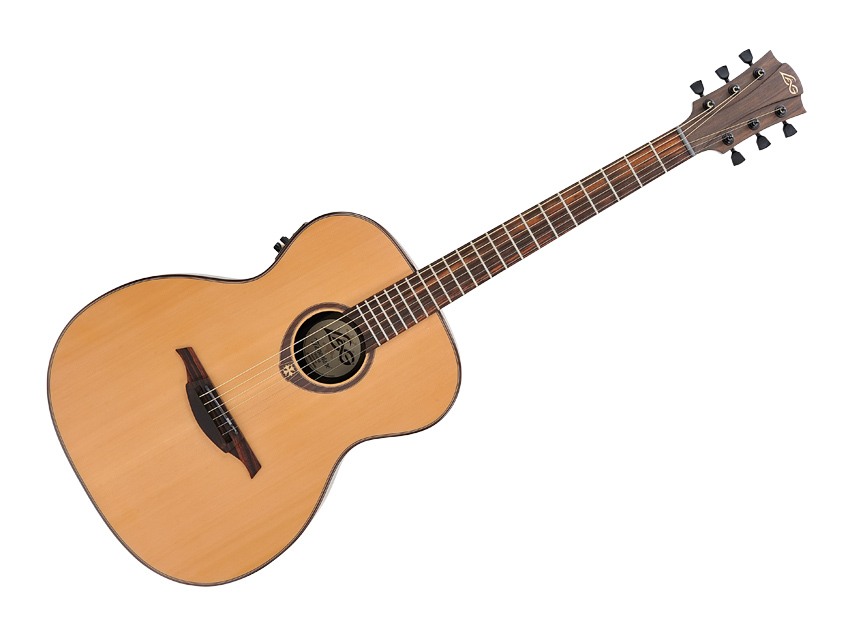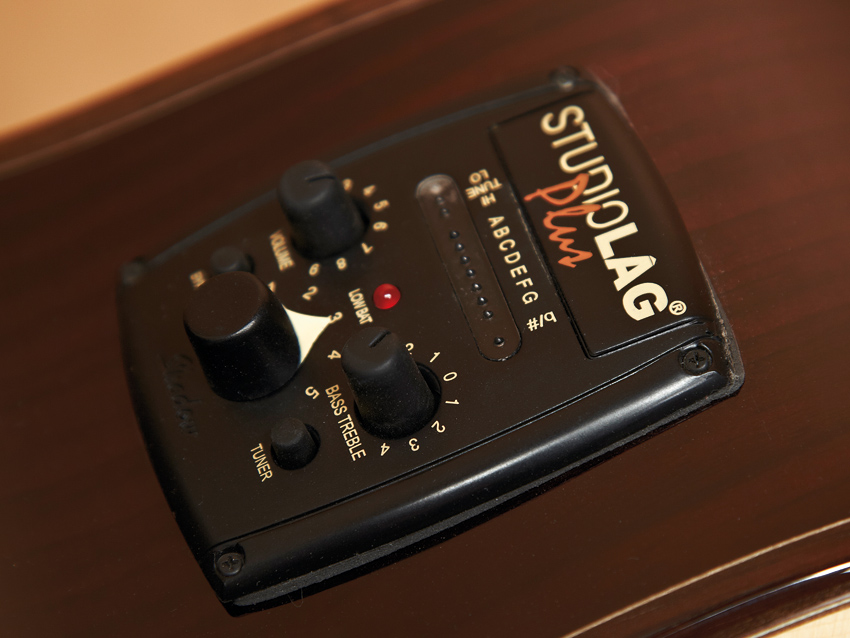MusicRadar Verdict
A beautifully presented electro that's best suited to amplified duties.
Pros
- +
Superb electronics; elegant looks; non-cutaway body shape.
Cons
- -
Acoustic tone could have more depth.
MusicRadar's got your back

Lag Tramontaine T300AE

Lag Tramontaine T300AE
The T300AE's shares its solid red cedar top, Indonesian bridge, headstock face and soundhole rosette with its stablemate the T200D. Its laminate back and sides are constructed from Indonesian rosewood, which Lag hasn't stained or darkened, so it looks comparatively light.
With its larger-than-a-folk dimensions, it's generally accepted that this finger-friendly auditorium body shape offers an ideal compromise between the clout of a dread or jumbo and the articulate clarity of a small-bodied guitar.
The T300AE features a pinless bridge. This through-bridge design will appeal to gigging players, as string changing is considerably quicker and easier if bridge pins don't need to be extricated.
Some would argue that not having the strings penetrate the soundboard has a detrimental effect on tone; the fundamental anchoring of the string through the top and bridgeplate is absent. For context, Takamine tends to employ a non-pinned bridge on its standard models, while traditionally minded models often get pinned bridges. In any case, the impressive standard of build quality is further evident here on the T300AE, as is the excellent satin finish.
As the 'E' denotes, this is an electro-acoustic model and it features the Studio Lag Plus system, designed and produced in close association with German pickup specialists, Shadow. The system's control panel boasts a complement of three rotaries and two push-button toggle switches.
Its key features are the five built-in EQ presets. Each has been individually created by using a 31-band professional equaliser and then integrated into the onboard preamp. Switching between the presets using the notched rotary is simple, though a bypass can be engaged to allow the bass/treble sweep to be utilised instead.
The presets are named by Lagas: (1) Natural Folk, (2) Mellow Mids, (3) Studio Mid‑Cut, (4) Fingerstyle and (5) Mellow Jazz. The system also includes a chromatic tuner (which engages whether a cable is plugged in or not) and alow‑battery indicator light.
Access to the two CR2032 batteries is via a sliding cover at the top of the control panel. Shadow quotes anything from 160 to over 700 hours use for similar models in its own line: either way, that's a lot of gigs.
Sounds
Acoustically we have a tight, bright tone. The small body shape, coupled with the use of rosewood (albeit a laminate), helps to produce a timbre that's sweet and not too brittle. It's responsive too, handling variations in dynamics well. In truth, though, plugged in is where this electro wants to be - the Studio Lag Plus system is a revelation.
Engaging the onboard electronics turns a run-of-the-mill acoustic tone into something much more usable. With the bypass switch depressed and the controls set flat, it immediately offers a full, balanced and powerful output. The bass/treble rotary performs its duties particularly well and sweeps the sound from a fuller, deep thud through to a bright and crisp 'zing'.
As impressive as the 'bypassed' output is, the fun really begins with the presets. On some modern image-shaping-type systems, it's sometimes difficult to hear big differences between the tone of the available presets - not so here. Each position offers a markedly different tone - distinct from any of the other four - and perfectly usable depending on the setting:
· Preset 1 has high output, though remaining perfectly clear and free of distortion.
· 2 is the sweetest, most mellow of the options, and it works particularly well for bluesy-style chord work and single-note runs.
· 3 has the biggest-sounding output, providing less detail than 1 or 4 but a huge, ethereal sound with a massive bass and a chime-like top end.
· 4 has bags of clarity and definition, well suited to fingerstyle and, with less output, better suited to the stage.
· 5 is a deep, mellow output with soft but precise highs that we'd suggest works well with gently strummed jazzy chords and which responds well to palm-muting too.
Additional tweaking of the preset can be achieved by using the bass/treble rotary, though in practice it serves only as a tone pot and we'd suggest best results are achieved when it's left flat, allowing the preset to sing out unaffected.
In short, we love the tonal options on offer. The only downside is the propensity to feed back. In tests, we rarely had the volume dialled in over halfway - anything more and we began to lose control.
So, although the acoustic tone is somewhat standard fare, the Studio Lag Plus system is reason alone to want this guitar.
Steve Harvey is senior content producer for Pro Sound News and also contributes to other Future brands. He has worked in the pro audio industry — as a touring musician as well as in live production, installed sound, and equipment sales and marketing — since November 1980.
“The most musical, unique and dynamic distortion effects I’ve ever used”: Linkin Park reveal the secret weapon behind their From Zero guitar tone – and it was designed by former Poison guitarist Blues Saraceno’s dad
Arturia’s V Collection gets a Roland JP-8000 emulation and lo-fi synth/sampler, along with five more instruments and a host of updates
Capture the sound of The Last of Us season 2's haunting soundtrack with Spitfire Audio’s latest software instrument, Ronroco by Gustavo Santaolalla









